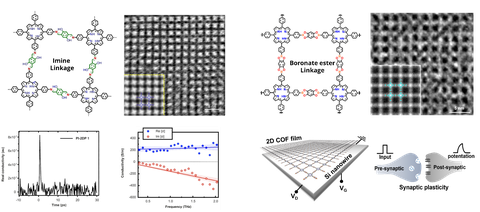03.03.2020
Functional two-dimensional polymers enabled by interfacial synthesis

Left : Imine-based 2D COF/polymer and its semiconducting property Right : Boronate ester-based 2D COF/polymer and its neuromorphic memory device application
Two-dimensional covalent organic frameworks (2D COFs) or layer-stacked 2D polymers, as rising organic 2D materials, have been enormously developed via reversible covalent reactions by solvothermal synthesis method, and have exhibited great potential as activesemiconducting layers for (opto-)electronics. However, since solvothermal synthesis of organic crystals is inclined toward to poorly controlled nucleation and aggregation, the resultant 2D COFs are usually in the form of polycrystalline powders. Therefore, incorporation of these insoluble 2D COF powders into thin film logic and memory devices represents a formidable challenge due to the difficulty in thin-film processability and device integration associated with the necessity of controlling film thickness, layer orientation, stability and crystallinity.
To address these synthetic and application challenges, a group of scientists from Technische Universität Dresden (TUD, Chair for Molecular Functional Materials) and collaborators have developed novel synthesis of large-area, free-standing, crystalline, few-layer 2D COF/polymer films utilizing a surfactant-monolayer-assisted interfacial synthesis (SMAIS) method on water surface for opening up exciting opportunity for the integration of 2D polymers into devices and systems. Mr. Hafeesudeen Sahabudeen synthesized three polycrystalline multilayer imine-based 2D COF/polymer films with tunable thickness from 6 to 200 nm via SMAIS method and unveiled the crystalline structures at the molecular lever by HRTEM in close collaboration with Prof. Ute Kaiser (Uni Ulm). The achieved crystalline 2D COF/polymer film with in-plane orientation exhibits a transient mobility as high as 0.01 cm2V-1s-1 as characterized by THz spectroscopy in collaboration with Prof. Mischa Bonn (MPIP) and Prof. Enrique Cánovas (IMDEANanociencia). This work establishes the clear structure-transport property relationship, which is a significant step for the development of semiconducting 2D COFs/polymers as well as their future FET device integration. To further explore the crystallinity and thin-film processability of 2D COF/polymer films, Mr. SangWook Park synthesized boronate ester-based 2D COF/polymer thin films with the single crystalline domains as large as ~60 μm2, which is a record to those of reported 2D COF films. Due to the high crystallinity, facile thin-film processability, high mechanical stability as well as the incorporation of electroactive porphyrin monomers, in collaboration with Prof. Gianaurelio Cuniberti (TUD), the developed few-layer 2D COF/polymer film was for the first time integrated into an organic thin film/Silicon nanowire-based field-effect transistor to mimic neuronal synapses, displaying a learning-erasing-forgetting memory process. This work broadens the interfacial synthesis of highly crystalline, few-layer 2D COF/polymer thin films and opens up a new area for developing such emergent materials as active components in memory devices for future neuromorphic computing, which also provides possibilities for the future development of COF-based flexible and wearable logic and memory electronics.
References:
- Hafeesudeen Sahabudeen#, Haoyuan Qi#, Marco Ballabio, Miroslav Položij, Selina Olthof, Rishi Shivhare, Yu Jing, SangWook Park, Kejun Liu, Tao Zhang, Ji Ma, Bernd Rellinghaus, Stefan Mannsfeld, Thomas Heine, Mischa Bonn, Enrique Cánovas, Zhikun Zheng,* Ute Kaiser,* Renhao Dong,* Xinliang Feng*. Highly Crystalline and Semiconducting Imine-Based Two-Dimensional Polymers Enabled by Interfacial Synthesis. Angew. Chem. Int. Ed. 2020, DOI: 10.1002/anie.201915217.
- SangWook Park, Zhongquan Liao, Bergoi Ibarlucea, HaoyuanQi, Hung-Hsuan Lin, Daniel Becker, Jason Melidonie, TaoZhang, Hafeesudeen Sahabudeen, Larysa Baraban, Chang-Ki Baek, Zhikun Zheng, Ehrenfried Zschech, Andreas Fery, Thomas Heine, Ute Kaiser, Gianaurelio Cuniberti, Renhao Dong,* Xinliang Feng*. Two-Dimensional Boronate Ester Covalent Organic Framework Thin Films with Large Single Crystalline Domains for Neuromorphic Memory Device. Angew. Chem. Int. Ed. 2020, DOI: 10.1002/ange.201916595.
Acknowledgement:
This work was financially supported by Graphene Flagship (Core 3), ERC Grants on T2DCP and FC2DMOF (grant agreement No. 852909) and COORNET (SPP 1928) as well as the German Science Council and Centre of Advancing Electronics Dresden, EXC1056, (cfaed)and OR 349/1. This project has received funding from the European Union's Horizon 2020 research and innovation programme under grant agreement 785219. Dr. Haoyuan Qi. and Prof. Ute Kaiser thank the financial support by the DFG in the framework of the “SALVE” (Sub‐Angstrom Low‐Voltage Electron Microscopy) project as well the Ministry of Science, Research and the Arts (MWK) of Baden‐Wuerttemberg in the framework of the SALVE project. Prof. Zhikun Zheng thanks financial support from the National Natural Science Foundation of China (51873236).We thank Dresden Center for Nanoanalysis (DCN) at TUD and Dr. Petr Formanek (Leibniz Institute for Polymer Research, IPF, Dresden) and Christine Damm (IFW) for the use of facilities. GIWAXS was carried out at DESY, a member of the Helmholtz Association (HGF), and at Helmholtz‐Zentrum Berlin. We would like to thank M. Schwartzkopf for assistance (P03‐MINAXS beamline) and Dr. Daniel Többens (KMC‐2 beamline). We thank HGF and HZB for the allocation of neutron/synchrotron radiation beamtime and ZIH Dresden for computer time.We gratefully acknowledge the International Excellence Graduate School on Emerging Materials and Processes Korea (iEGSEMP Korea) in the context of TU Dresden Institutional Strategy The Synergetic University.
